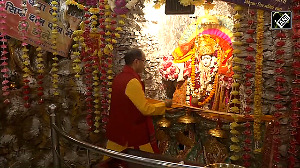Seshagiri Rao, director (finance), JSW Steel, said that prices would be cut across products, from hot-rolled to galvanised, on the back of the government on Sunday announcing a 4 per cent cut in the Cenvat rate. In absolute terms, prices are likely to come down by Rs 1,000-1,400 a tonne.
Steel prices have come down by around 40 per cent since July this year. At present, prices of hot-rolled coil are ruling at Rs 30,000-32,000 a tonne.
Ispat Industries director (finance) Anil Sureka said ex-factory prices of hot rolled coils were even lower.
He said the cut in steel prices would be automatic and the 4 per cent reduction would be passed on to the consumers.
An Essar Steel spokesperson said that the company would have to go through the notification first and then take a call on the extent and products where prices could be reduced.
Arvind Parakh, director for strategy and business development, Jindal Stainless, said overall cost would come down and so eventually prices would also decrease.
Sureka also feels that the package coupled with the Reserve Bank of India measures announced on Saturday would get the economy ticking once more.
"We are expecting another booster from RBI, which would should get the economy ticking," Surekha added.
Also, the reduction in car prices on the back of the reduction in the ad valorem CENVAT rate, was likely to boost demand for steel.
"It will have a cascading effect," said Sureka.
The boost for demand had become necessary for the steel sector as almost all major producers had cut their production on the back of large-scale inventory pile-up.
Rao, meanwhile, said that the Rs 20,000-crore (Rs 200-billion) Plan expenditure will also help boost demand though the package is a little short of expectations.
However, he feels that the elimination of export duty on iron ore fines would be a dampener for smaller steel producers who source iron ore from private miners.
"The international demand is so low and China
Meanwhile, the government's decision to cut export duty on iron ore -- to zero on fines and to five per cent on lumps - has brought some relief for miners as the move is expected to give the much-needed boost to the industry reeling under the pressure of low demand and fall in prices.
RK Sharma, secretary general, Federation of Indian Mineral Industries, said that the government's initiative to eliminate export duty on iron ore fines was likely to boost exports in the next few months.
Export of iron ore fines in November was lower by 50 per cent over the same period last year.
During the April-November period, it was 16 per cent lower.
Sharma said last year exports were to the tune of 104 million tonnes (mt) but this year it was expected to be around 80 mt.
"Chinese buyers are not so forthcoming now," he said. Of the 104 mt of exports, 94 mt were to China. South Korea and Japan buy from India mostly through long-term contracts.
However, the industry felt that the duty on lump ore, which had been brought down to 5 per cent from 15 per cent, should be eliminated as well.
Agrees Ravi Kastia, managing director and chief executive officer, Essel Mining. "I don't think the government can continue with the 5 per cent duty it would have to be eliminated, but it wants lumps to be given to local players," he said.
Sharma said lumps from the eastern sector were not exported, whereas those from Bellary-Hospet in Karnataka and Goa were exported.
"There is no domestic demand for Bellary-Hospet and Goa lumps. So the duty should be removed," he added.
Iron ore prices had dropped significantly in the past few months. Prices of iron ore fines had come down from $145 a tonne to $50 a tonne over the period.
Kastia said the duty restructuring would not have any impact on prices in the immediate term but would make projects more viable.
However, if the demand picks up in China on the back of the package announced by its government, it could drive prices up from the current levels.







 © 2025
© 2025